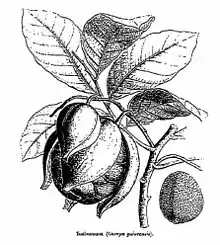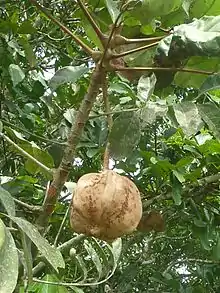Carapa procera
Carapa procera, called African crabwood, is a species of tree in the genus Carapa, native to the West African tropics and to the Amazon rainforest, and introduced to Vietnam.[2] Some authorities have split off the South American population into its own species, Carapa surinamensis.[3] The nuts are intensively collected in the wild for their oil, a non-timber forest product.[4] In tropical Africa, the species is increasingly threatened.[5]
| Carapa procera | |
|---|---|
 | |
| Botanical illustration | |
 | |
| Ripe nut | |
| Scientific classification | |
| Kingdom: | Plantae |
| Clade: | Tracheophytes |
| Clade: | Angiosperms |
| Clade: | Eudicots |
| Clade: | Rosids |
| Order: | Sapindales |
| Family: | Meliaceae |
| Genus: | Carapa |
| Species: | C. procera |
| Binomial name | |
| Carapa procera | |
| Synonyms[2] | |
|
List
| |
References
- Prodr. 1: 626 (1824)
- "Carapa procera DC". Plants of the World Online. Board of Trustees of the Royal Botanic Gardens, Kew. 2017. Retrieved 25 December 2020.
- "Carapa surinamensis Miq". Plants of the World Online. Board of Trustees of the Royal Botanic Gardens, Kew. 2017. Retrieved 25 December 2020.
- Forget, Pierre-Michel; Jansen, Patrick A. (2007). "Hunting Increases Dispersal Limitation in the Tree Carapa procera, a Nontimber Forest Product". Conservation Biology. 21 (1): 106–113. doi:10.1111/j.1523-1739.2006.00590.x. PMID 17298516.
- Fanta Reine Sheirita Tiétiambou; Kolawolé Valère Salako; Jésukpégo Roméo Tohoun; Amadé Ouédraogo (23 July 2020). "Local preferences for three indigenous oil-seed plants and attitudes towards their conservation in the Kénédougou province of Burkina Faso, West-Africa". Journal of Ethnobiology and Ethnomedicine. 16 (1): 43. doi:10.1186/S13002-020-00393-1. ISSN 1746-4269. PMC 7376732. PMID 32703227. Wikidata Q97679959. (erratum)
This article is issued from Wikipedia. The text is licensed under Creative Commons - Attribution - Sharealike. Additional terms may apply for the media files.